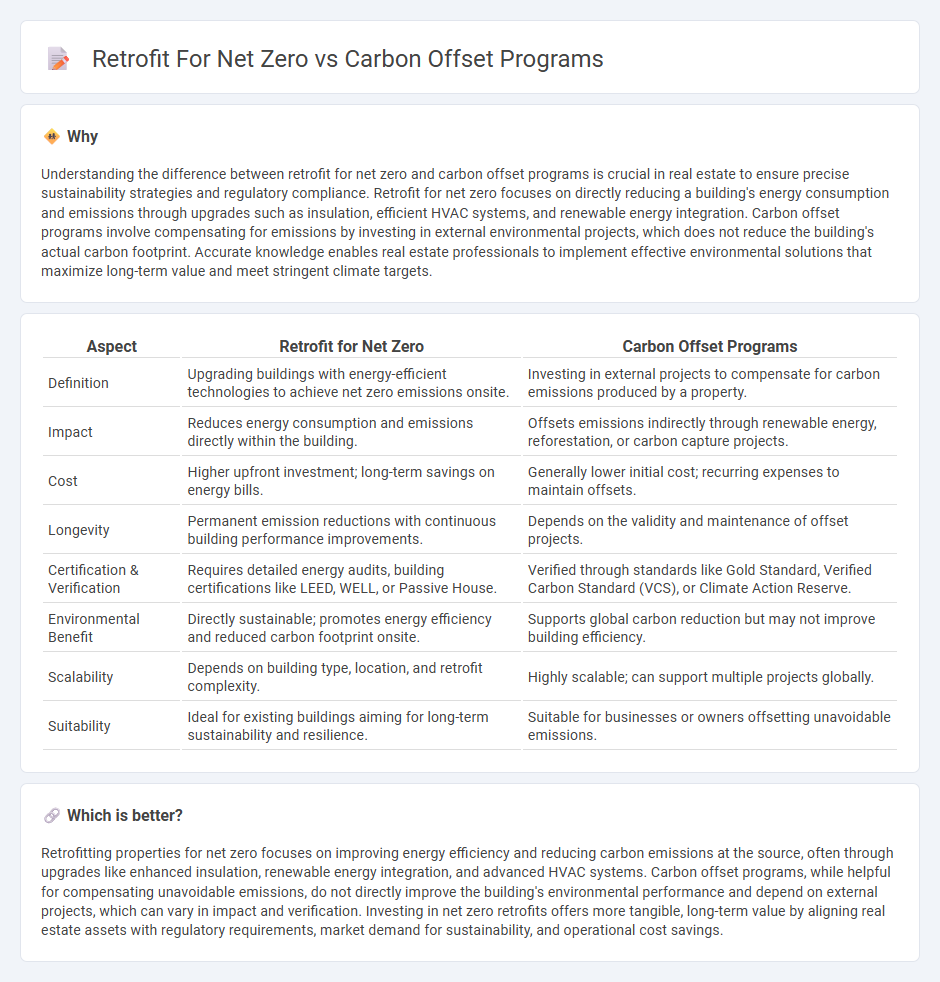
Retrofitting existing buildings for net zero energy involves upgrading insulation, installing energy-efficient windows, and integrating renewable energy systems to drastically reduce carbon emissions at the source. Carbon offset programs compensate for emissions by investing in projects such as reforestation or renewable energy, but do not directly reduce a building's energy consumption. Explore how combining retrofit strategies with carbon offset initiatives can maximize sustainability impacts in real estate.
Why it is important
Understanding the difference between retrofit for net zero and carbon offset programs is crucial in real estate to ensure precise sustainability strategies and regulatory compliance. Retrofit for net zero focuses on directly reducing a building's energy consumption and emissions through upgrades such as insulation, efficient HVAC systems, and renewable energy integration. Carbon offset programs involve compensating for emissions by investing in external environmental projects, which does not reduce the building's actual carbon footprint. Accurate knowledge enables real estate professionals to implement effective environmental solutions that maximize long-term value and meet stringent climate targets.
Comparison Table
| Aspect | Retrofit for Net Zero | Carbon Offset Programs |
|---|---|---|
| Definition | Upgrading buildings with energy-efficient technologies to achieve net zero emissions onsite. | Investing in external projects to compensate for carbon emissions produced by a property. |
| Impact | Reduces energy consumption and emissions directly within the building. | Offsets emissions indirectly through renewable energy, reforestation, or carbon capture projects. |
| Cost | Higher upfront investment; long-term savings on energy bills. | Generally lower initial cost; recurring expenses to maintain offsets. |
| Longevity | Permanent emission reductions with continuous building performance improvements. | Depends on the validity and maintenance of offset projects. |
| Certification & Verification | Requires detailed energy audits, building certifications like LEED, WELL, or Passive House. | Verified through standards like Gold Standard, Verified Carbon Standard (VCS), or Climate Action Reserve. |
| Environmental Benefit | Directly sustainable; promotes energy efficiency and reduced carbon footprint onsite. | Supports global carbon reduction but may not improve building efficiency. |
| Scalability | Depends on building type, location, and retrofit complexity. | Highly scalable; can support multiple projects globally. |
| Suitability | Ideal for existing buildings aiming for long-term sustainability and resilience. | Suitable for businesses or owners offsetting unavoidable emissions. |
Which is better?
Retrofitting properties for net zero focuses on improving energy efficiency and reducing carbon emissions at the source, often through upgrades like enhanced insulation, renewable energy integration, and advanced HVAC systems. Carbon offset programs, while helpful for compensating unavoidable emissions, do not directly improve the building's environmental performance and depend on external projects, which can vary in impact and verification. Investing in net zero retrofits offers more tangible, long-term value by aligning real estate assets with regulatory requirements, market demand for sustainability, and operational cost savings.
Connection
Retrofitting buildings for net zero involves upgrading insulation, windows, HVAC systems, and renewable energy installations to significantly reduce carbon emissions. These improvements directly contribute to carbon offset programs by lowering a property's carbon footprint, allowing owners to earn or purchase carbon credits that balance out residual emissions. Integrating net zero retrofits with carbon offset initiatives creates a synergistic approach to sustainable real estate, enhancing environmental impact and meeting regulatory or market-driven climate targets.
Key Terms
Emissions Reduction
Carbon offset programs primarily compensate for emissions by funding projects such as reforestation or renewable energy initiatives, whereas retrofit strategies directly reduce emissions by upgrading existing infrastructure with energy-efficient technologies. Retrofitting buildings and industrial systems often yields immediate and measurable reductions in greenhouse gas emissions, contributing significantly to net zero goals. Explore detailed comparisons to determine the most effective approach for achieving sustainable emissions reduction.
Energy Efficiency
Carbon offset programs compensate for greenhouse gas emissions by investing in projects that reduce or capture carbon elsewhere, but they do not directly improve the energy efficiency of a building or system. Retrofit initiatives enhance net zero efforts by upgrading existing infrastructure with advanced technologies such as high-efficiency HVAC systems, LED lighting, and better insulation to reduce energy consumption at the source. Explore detailed strategies to optimize energy efficiency and achieve comprehensive net zero goals effectively.
Renewable Energy
Carbon offset programs invest in renewable energy projects like wind farms and solar installations to compensate for carbon emissions by generating clean energy elsewhere. Retrofit initiatives focus on upgrading existing buildings with energy-efficient technologies, such as solar panels and advanced HVAC systems, to reduce onsite fossil fuel consumption directly. Explore detailed comparisons to understand which strategy best supports your net zero goals.
Source and External Links
Carbon Offset Programs Guide and Examples for 2025 - This guide provides an overview of carbon offset programs, including Verra and the Verified Carbon Standard (VCS), which offer projects to reduce carbon footprints.
Carbon Offset Program - Southwest Airlines offers a carbon offset program that allows customers to purchase offsets from projects like reforestation and coastal conservation.
Carbon Offsets - Carbon offsets are certificates that fund projects reducing CO2 emissions, such as reforestation or renewable energy, to balance emissions elsewhere.
 dowidth.com
dowidth.com